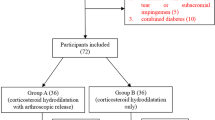Abstract
We compared the effect of subcutaneous adalimumab injections with intraarticular glucocorticoid injections on frozen shoulder of 18 patients with unilateral joint involvement. Ten patients were randomised to subcutaneous injections with adalimumab and eight to intraarticular glucocorticoid injections administered every other week for a total of three administrations. The evaluation included validated scores. No effect of subcutaneous injections of adalimumab on frozen shoulder symptoms was demonstrated.
Similar content being viewed by others
References
Gam A, Schydlowsky P, Rossel I, Remvig L, Jensen EM (1998) Treatment of “frozen shoulder” with distension and glucorticoid compared with glucocorticoid alone. Scand J Rheumatol 27:425–430
Rizk TE, Pinals RS, Talaiver AS (1991) Corticosteroid injections in adhesive capsulitis. Arch Phys Med Rehabil 72:20–22
Bulgen DY, Binder AI, Hazleman BL, Dutton J, Roberts S (1984) Frozen shoulder: prospective clinical study with an evaluation of three regimens. Ann Rheum Dis 43:353–360
Bunker TD, Reilly J, Baird KS, Hambien DC (2000) Expression of growth factors, cytokines, matrix metalloproteinases in frozen shoulder. J Bone Joint Surg 82B:768–773
Furst DE, Schiff MH, Fleischmann RM, Strand V, Birbara CA, Compagnone D et al (2003) Adalimumab, a fully human anti-tumor necrosis factor-a monoclonal antibody, and concomitant standard antirheumatic therapy for the treatment of rheumatoid arthritis: results of STAR (safety trial of adalimumab in rheumatoid arthritis). J Rheumatol 30:2563–2571
Keystone EC, Kavanaugh AF, Sharp JT, Tannenbaum H, Hua Y, Teoh LS et al (2004) Radiographic, clinical, and functional outcomes of treatment with adalimumab (a human anti-tumor necrosis factor monoclonal antibody) in patients with active rheumatoid arthritis receiving concomitant methotrexate therapy. Arthritis Rheum 50:1400–1411
Weinblatt ME, Keystone EC, Furst DE, Moreland LW, Weisman MH, Birbara CA et al (2003) Adalimumab, a fully human anti-tumor necrosis factor alpha monoclonal antibody, for the treatment of rheumatoid arthritis in patients taking concomitant methotrexate: the ARMADA trial. Arthritis Rheum 48:35–45
van de Putte LBA, Atkins C, Malaise M, Sany J, Russell AS, van Riel PL et al (2004) Efficacy and safety of adalimumab as monotherapy in patients with rheumatoid arthritis for whom previous disease modifying antirheumatic drug treatment has failed. Ann Rheum Dis 63:508–516
Abbott Laboratories (2002) Adalimumab (Humira): product summary. North Chicago 1–14
Codman EA (1934) The shoulder: rupture of the supraspinatus tendon and other lesions in or about the subacromial bursa. Thomas Todd Co., Boston
Constant CR, Murlay AHG (1987) A clinical method of functional assessment of the shoulder. Clin Orthop Relat Res 214:160–164
L’Insalata JC, Warren RF, Cohen SB, Altchek DW, Peterson MG (1997) A self-administered questionnaire for assessment of symptoms and function of the shoulder. J Bone Joint Surg 79A:738–748
Williams JW, Holleman DR Jr, Simel DL (1995) Measuring shoulder function with the shoulder pain and disability index. J Rheumatol 22:727–732
Roach KE, Budiman-Mak E, Songsiridej N, Lertratanakul Y (1991) Development of a shoulder pain and disability index. Arthritis Care Res 4:143–149
Buchbinder R, Hoving JL, Green S, Hall S, Forbes A, Nash P (2004) Short course prednisolone for adhesive capsulitis (frozen shoulder or stiff painful shoulder): a randomised, double blind, placebo-controlled trial. Ann Rheum Dis 63:1460–1469
Rodeo SA, Hannafin JA, Tom J, Warren RF, Wickiewicz TL (1997) Immunolocalization of cytokines and their receptors in adhesive capsulitis of the shoulder. J Orthop Res 15:427–436
Bunker TD, Anthony PP (1995) The pathology of frozen shoulder—a Dupuytren-like disease. J Bone Joint Surg Br 77:677–678
Acknowledgments
This study was funded by Abbot Pharmaceuticals, Denmark. Abbott Denmark had no influence on, or involvement in, the planning or design of the study, data collection, data analysis or manuscript preparation. We thank Abbott Pharmaceuticals for the financial support and technical assistance.
Disclosures
Pierre Schydlowsky has received consulting fees from Abbott. Ole Rintek Madsen has received consulting fees, speaking fees and research grants from Abbott. Marcin Szkudlarek has no financial grants to disclose.
Author information
Authors and Affiliations
Corresponding author
Rights and permissions
About this article
Cite this article
Schydlowsky, P., Szkudlarek, M. & Madsen, O.R. Treatment of frozen shoulder with subcutaneous TNF-alpha blockade compared with local glucocorticoid injection: a randomised pilot study. Clin Rheumatol 31, 1247–1251 (2012). https://doi.org/10.1007/s10067-012-1993-5
Received:
Revised:
Accepted:
Published:
Issue Date:
DOI: https://doi.org/10.1007/s10067-012-1993-5




